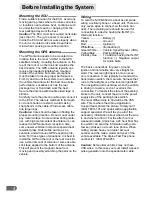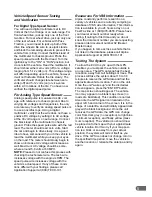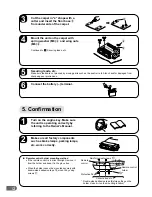
5
Vehicle Speed Sensor Testing
and Verification
For Digital Type Speed Sensor:
You will need a digital multimeter set to DC
Volts at the 30 volt range or on auto-range. For
front wheel drive, jack up only one of the front
two tires. For rear wheel drive, jack up only one
of the rear wheels. For vehicles with Posi-
Traction, you will need to jack up both of the
drive line wheels. Be sure to use jack stands
and block the remaining wheels to prevent the
vehicle from rolling. Connect the Black lead of
the multimeter to chassis ground. Probe the
speed pulse wire with the Red lead. Turn the
ignition key to the "ON" or "RUN" position, but
do not start the vehicle. Read the multimeter. It
should show either zero volts (off) or a voltage
ranging from 5-12 volts (on). This voltage range
will differ depending upon the vehicle, however
it will not fluctuate. Rotate the tire slowly. The
voltmeter should change state between zero
volts (off) and 5-12 volts (on) or vice-versa
within 2-3 rotations of the tire. You have now
verified the digital speed pulse.
For Analog Type Speed Sensor
Analog speed pulse is measured as AC volt-
age, with reference to chassis ground. Due to
varying AC voltages and frequencies, the only
accurate way to verify an analog speed pulse is
to use an oscilloscope. Using a digital
multimeter, verify that the wire does not have a
positive DC voltage by setting it to AC voltage
at the 30 volt range or on auto-range. Connect
the black lead of the multimeter to chassis
ground. Probe the speed pulse wire with the red
lead. The meter should read zero volts. Start
the car and begin to drive slowly. It is a good
idea to have someone with you in the vehicle to
read the multimeter while you keep your eyes
on the road. The meter should slowly begin to
show an increase AC voltage will increase as
well. Maximum AC voltage should be some-
where around 5-8 volts at 60 MPH.
NOTE: Please do not confuse this process with
checking the tachometer wire. The tach wire
increases voltage with the engine's RPM. The
speed pulse wire increases voltage with the
vehicle's actual speed. If any of these condi-
tions differ with your findings, please call
Application Support at (800) TECH-101.
Resources For VSS Information
Alpine constantly performs research on a
variety of vehicles and is currently compiling a
database of VSS wire information. This informa-
tion is available to you 24 hours a day on our
Fast Fax line at 1 (800)978-9655. Please have
your dealer account number ready when
calling. If calling for first time and you do not
know the document number you are requesting,
please order document number 02 (Dealer
Master Index).
If you happen to come across a vehicle that is
not listed in the database, please call Alpine
Application Support at (800) TECH-101.
Testing The System
To allow the ECU to sync up with the GPS
satellites you must park the vehicle outside in
an open area. The GPS antenna has the best
reception, away from tall buildings or trees. This
process will take the system about 10 to 30
minutes to receive the GPS data and find the
approximate vehicle location. Turn on the unit.
Once the unit "wakes up" and the disclaimer
screen appears, press the "ENTER" button.
The map screen should appear. The vehicle
icon may appear on a blank map screen (no
roads are illustrated). This condition is normal.
Also note the GPS signal icon located on the
upper left hand corner of the screen. It is in the
shape of a satellite, and will initially appear dark
grey with a black background. Once the unit
receives the GPS data, the GPS icon change
color from dark grey (no reception), to light blue
(minimum reception), and finally yellow (maxi-
mum reception). The vehicle icon should now
be placed onto the map with your approximate
vehicle location. Don't worry if your map posi-
tion is a block or so away from your actual
position, the system will correct itself as you
drive. If the GPS icon does not change color in
the specified time period, move the vehicle to
another location or relocate the antenna and try
again.

































